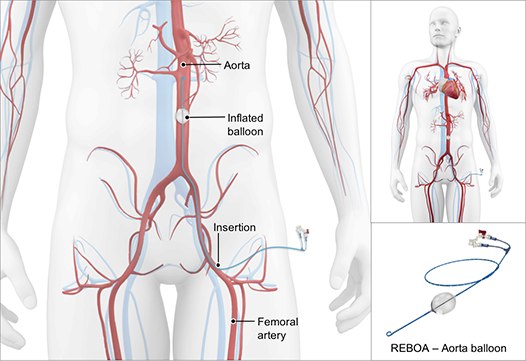Noncompressible torso hemorrhage, often resulting from exposure to a blast event, is a leading cause of potentially preventable death in contemporary military conflicts. In recent years, the use of the surgical technique, resuscitative endovascular occlusion of the aorta (REBOA), has emerged as a treatment for this type of hemorrhage. The technique involves inserting a flexible catheter into the femoral artery and maneuvering it into the aorta, the main artery in the human body. Once in place, a small balloon at the tip of the catheter is inflated which prevents the flow of blood past the balloon and effectively stops the uncontrolled bleeding. While many researchers have demonstrated the effectiveness of REBOA for noncompressible torso hemorrhage in civilian hospital and prehospital settings, the possibility of performing REBOA in a far forward military environment has yet to be demonstrated.
Researchers from the Department of War Surgery at the Kirov Military Medical Academy (Russia) and the Travis Air Force Base Medical Center (USA) investigated the feasibility of REBOA in an austere prehospital environment during a military readiness exercise. In the exercise, REBOA was performed on swine models of noncompressible hemorrhage either in the field at the point of injury or during a simulated helicopter medical evacuation. In both instances, REBOA was performed by a casualty care team composed of two physicians, one anesthetist, and one anesthetist nurse. In spite of challenges such as low light conditions, complications accessing site of injury, and use of portable technologies in the field, researchers demonstrated that REBOA can be effectively performed in simulated battlefield conditions.
Findings suggest that REBOA is a viable option for the management of noncompressible torso hemorrhage in austere locations, representing a possible opportunity to save the lives of future Service Members on the battlefield who have been injured by blast. However, as far forward military environments are often unpredictable and extend across a wide variety of medical capabilities, future work is needed to determine the optimal training and utilization protocols to effectively incorporate REBOA into military prehospital settings.

Reva VA, Hörer TM, Makhnovskiy AI, Sokhranov MV, Samokhvalov IM, DuBose JJ. (2017). Field and en route resuscitative endovascular occlusion of the aorta: A feasible military reality? J Trauma Acute Care Surg. 83(1 Suppl 1):S170-S176. doi: 10.1097/TA.0000000000001476.
Findings from this study were also presented at the annual meeting of the Ambriose Pare International Military Surgical Forum, October 2-3, 2016, in Berlin, Germany.
Your 15 minute session will timeout in approximately 10 minutes.
If you're in the middle of entering information, please close this warning and save your progress (if possible) or finish up your task.
If your session fully times out, you will lose any un-saved work.
Your current Blast Injury Research Program session has expired.
Your next click will take you away from the private area, and you will lose any work you have in-progress.
Please enter your email address, and try again.